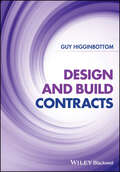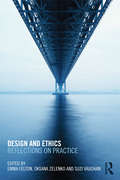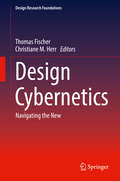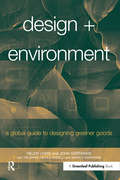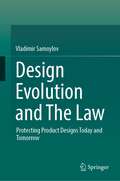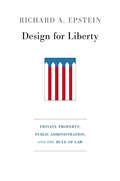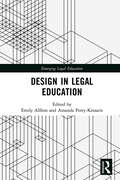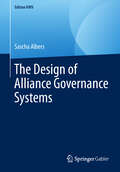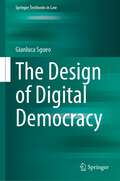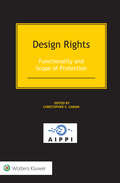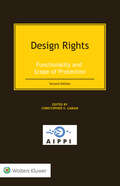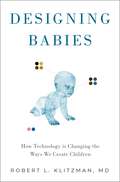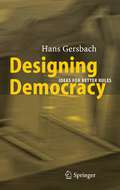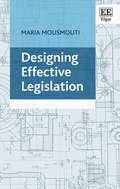- Table View
- List View
Deserved Criminal Sentences
by Andreas Von HirschThis book provides an accessible and systematic restatement of the desert model for criminal sentencing by one of its leading academic exponents. The desert model emphasises the degree of seriousness of the offender's crime in deciding the severity of his punishment, and has become increasingly influential in recent penal practice and scholarly debate. It explains why sentences should be based principally on crime-seriousness, and addresses, among other topics, how a desert-based penalty scheme can be constructed; how to gauge punishments' seriousness and penalties' severity; what weight should be given to an offender's previous convictions; how non-custodial sentences should be scaled; and what leeway there might be for taking other factors into account, such as an offender's need for treatment. The volume will be of interest to all those working in penal theory and practice, criminal sentencing and the criminal law more generally.
Design and Build Contracts
by Guy HigginbottomDESIGN AND BUILD CONTRACTS Design and build (D&B) construction procurement relies on a project’s main contractor shouldering the responsibility for creating the design and executing the construction for a project. While the extent of contractor-produced design can vary, this method of construction procurement affords the contractor a greater level of input and responsibility than traditionally procured contracts (where the employer has greater design responsibility). Over the last decade in the UK, it has become clear that D&B contracts are becoming the most popular method for procuring construction projects; often echoing the ways in which contracts for infrastructure and process plant can be procured. Whilst D&B can provide a greater degree of contractor input for producing feasibility and concept designs, then the detailed design to deliver a project, many clients amend standard forms of D&B contracts to alter the contractors’ design input. This can significantly change D&B, deviating from the procedures set out in the standard forms of D&B contract. This book firstly takes the reader through each stage of a project (based upon the RIBA Plan of Work 2020) to provide guidance on how D&B contracts were intended to operate, then secondly, identifying how D&B contracts and their procedures have changed. Readers will find: Outline commentary and guidance on commonly used standard forms of D&B contract, including: JCT Design and Build 2016; FIDIC Conditions of Contract for Plant Design-Build 2017; and NEC4 How each D&B contract is intended to operate during each stage of the RIBA Plan of Work 2020 How the operation of D&B contracts and their procedures are often amended. An ideal resource for contractors, employers, and consultants, as well as those studying construction at university, Design and Build Contracts offers helpful commentary and guidance for how each stage of a D&B engineering or construction project should progress.
Design and Build Contracts
by Guy HigginbottomDESIGN AND BUILD CONTRACTS Design and build (D&B) construction procurement relies on a project’s main contractor shouldering the responsibility for creating the design and executing the construction for a project. While the extent of contractor-produced design can vary, this method of construction procurement affords the contractor a greater level of input and responsibility than traditionally procured contracts (where the employer has greater design responsibility). Over the last decade in the UK, it has become clear that D&B contracts are becoming the most popular method for procuring construction projects; often echoing the ways in which contracts for infrastructure and process plant can be procured. Whilst D&B can provide a greater degree of contractor input for producing feasibility and concept designs, then the detailed design to deliver a project, many clients amend standard forms of D&B contracts to alter the contractors’ design input. This can significantly change D&B, deviating from the procedures set out in the standard forms of D&B contract. This book firstly takes the reader through each stage of a project (based upon the RIBA Plan of Work 2020) to provide guidance on how D&B contracts were intended to operate, then secondly, identifying how D&B contracts and their procedures have changed. Readers will find: Outline commentary and guidance on commonly used standard forms of D&B contract, including: JCT Design and Build 2016; FIDIC Conditions of Contract for Plant Design-Build 2017; and NEC4 How each D&B contract is intended to operate during each stage of the RIBA Plan of Work 2020 How the operation of D&B contracts and their procedures are often amended. An ideal resource for contractors, employers, and consultants, as well as those studying construction at university, Design and Build Contracts offers helpful commentary and guidance for how each stage of a D&B engineering or construction project should progress.
Design and Ethics: Reflections on Practice
by Emma Felton Oksana Zelenko Suzi VaughanThe value of design for contributing to environmental solutions and a sustainable future is increasingly recognised. It spans many spheres of everyday life, and the ethical dimension of design practice that considers environmental, social and economic sustainability is compelling. Approaches to design recognise design as a practice that can transform human experience and understanding, expanding its role beyond stylistic enhancement. The traditional roles of design, designer and designed object are therefore redefined through new understanding of the relationship between the material and immaterial aspects of design where the design product and the design process are embodiments of ideas, values and beliefs. This multi-disciplinary approach considers how to create design which is at once aesthetically pleasing and also ethically considered, with contributions from fields as diverse as architecture, fashion, urban design and philosophy. The authors also address how to teach design based subjects while instilling a desire in the student to develop ethical work practices, both inside and outside the studio.
Design and Ethics: Reflections on Practice
by Emma Felton Oksana Zelenko Suzi VaughanThe value of design for contributing to environmental solutions and a sustainable future is increasingly recognised. It spans many spheres of everyday life, and the ethical dimension of design practice that considers environmental, social and economic sustainability is compelling. Approaches to design recognise design as a practice that can transform human experience and understanding, expanding its role beyond stylistic enhancement. The traditional roles of design, designer and designed object are therefore redefined through new understanding of the relationship between the material and immaterial aspects of design where the design product and the design process are embodiments of ideas, values and beliefs. This multi-disciplinary approach considers how to create design which is at once aesthetically pleasing and also ethically considered, with contributions from fields as diverse as architecture, fashion, urban design and philosophy. The authors also address how to teach design based subjects while instilling a desire in the student to develop ethical work practices, both inside and outside the studio.
Design Cybernetics: Navigating the New (Design Research Foundations)
by Thomas Fischer Christiane M. HerrDesign Cybernetics: Navigating the New Design cybernetics offers a way of looking at ourselves – curious, creative, and ethical humans – as self-organising systems that negotiate their own goals in open-ended explorations of the previously unknown. It is a theory of and for epistemic practices (learning, designing, researching) that is deeply committed to the autonomy of others and hence offers no prescriptive methodology. Design cybernetics describes design practice as inextricable from conversation – a way of enquiring, developing shared understanding and reaching the new that harnesses reliable control as well as error and serendipity. Recognising circular causality, observer-dependency and non-determinability, design cybernetics extends beyond tenets of scientific research into the creative, ethical and aesthetic domain. From this perspective, design is not an ill-conceived subset of scientific research. Instead, scientific research emerges as a particularly restricted subset of the broader human activity of design. This volume offers a cross-section of design cybernetic theory and practice with contributions ranging across architecture, interior lighting studies, product design, embedded systems, design pedagogy, design theory, social transformation design, research epistemology, art and poetics, as well as theatre and acting. Addressing designers, design educators and researchers interested in a rigorous, practice-based epistemology, it establishes design cybernetics as a foundational perspective of design research. “This is a conceptually elegant, well structured, and comprehensive presentation of design cybernetics. It fills a gap in the literature of the field.” Ken Friedman, Chair Professor, Tongji University “This book offers a valuable and timely introduction to second-order cybernetics as society grapples with complex issues like climate change and rising inequality.” Joichi Ito, Director of the MIT Media Lab
Design + Environment: A Global Guide to Designing Greener Goods
by Helen Lewis John Gertsakis Tim Grant Nicola Morelli Andrew SweatmanThere is a huge scarcity of good, practical resources for designers and students interested in minimizing the environmental impacts of products. Design + Environment has been specifically written to address this paucity. The book first provides background information to help the reader understand how and why design for environment (DfE) has become so critical to design, with reference to some of the most influential writers, designers and companies in the field. Next, Design + Environment provides a step-by-step approach on how to approach DfE: to design a product that meets requirements for quality, cost, manufacturability and consumer appeal, while at the same time minimising environmental impacts. The first step in the process is to undertake an assessment of environmental impacts, using life-cycle assessment (LCA) or one of the many simpler tools available to help the designer. From then on, DfE becomes an integral part of the normal design process, including the development of concepts, design of prototypes, final design and development of marketing strategies. Environmental assessment tools and strategies to reduce environmental impacts, such as the selection of appropriate materials, are then discussed. Next, some of the links between environmental problems, such as global warming, ozone depletion, water and air pollution and the everyday products we consume are considered. In order to design products with minimal environmental impact, we need to have a basic understanding of these impacts and the interactions between them. The four subsequent chapters provide more detailed strategies and case studies for particular product groups: packaging, textiles, furniture, and electrical and electronic products. Guidelines are provided for each of the critical stages of a product's life, from the selection of raw materials through to strategies for recovery and recycling. Finally, Design + Environment takes a look at some of the emerging trends in DfE that are offering us the opportunity to make a more significant reduction in environmental impacts. Both the development of more sustainable materials and technologies and the growing interest in leasing rather than selling products are examined. Design + Environment is organized as a workbook rather than an academic text. It should be read once, and then used as a key reference source. This clear and informative book will prove to be invaluable to practising designers, to course directors and their students in need of a core teaching and reference text and to all those interested in learning about the tools and trends influencing green product design. The authors have all been involved in an innovative demonstration programme called "EcoReDesign", which was developed by the Centre for Design at RMIT University with funding from the Australian government. The Centre successfully collaborated with Australian companies to improve the environmental performance of their products by following DfE principles.
Design + Environment: A Global Guide to Designing Greener Goods
by Helen Lewis John Gertsakis Tim Grant Nicola Morelli Andrew SweatmanThere is a huge scarcity of good, practical resources for designers and students interested in minimizing the environmental impacts of products. Design + Environment has been specifically written to address this paucity. The book first provides background information to help the reader understand how and why design for environment (DfE) has become so critical to design, with reference to some of the most influential writers, designers and companies in the field. Next, Design + Environment provides a step-by-step approach on how to approach DfE: to design a product that meets requirements for quality, cost, manufacturability and consumer appeal, while at the same time minimising environmental impacts. The first step in the process is to undertake an assessment of environmental impacts, using life-cycle assessment (LCA) or one of the many simpler tools available to help the designer. From then on, DfE becomes an integral part of the normal design process, including the development of concepts, design of prototypes, final design and development of marketing strategies. Environmental assessment tools and strategies to reduce environmental impacts, such as the selection of appropriate materials, are then discussed. Next, some of the links between environmental problems, such as global warming, ozone depletion, water and air pollution and the everyday products we consume are considered. In order to design products with minimal environmental impact, we need to have a basic understanding of these impacts and the interactions between them. The four subsequent chapters provide more detailed strategies and case studies for particular product groups: packaging, textiles, furniture, and electrical and electronic products. Guidelines are provided for each of the critical stages of a product's life, from the selection of raw materials through to strategies for recovery and recycling. Finally, Design + Environment takes a look at some of the emerging trends in DfE that are offering us the opportunity to make a more significant reduction in environmental impacts. Both the development of more sustainable materials and technologies and the growing interest in leasing rather than selling products are examined. Design + Environment is organized as a workbook rather than an academic text. It should be read once, and then used as a key reference source. This clear and informative book will prove to be invaluable to practising designers, to course directors and their students in need of a core teaching and reference text and to all those interested in learning about the tools and trends influencing green product design. The authors have all been involved in an innovative demonstration programme called "EcoReDesign", which was developed by the Centre for Design at RMIT University with funding from the Australian government. The Centre successfully collaborated with Australian companies to improve the environmental performance of their products by following DfE principles.
Design Evolution and The Law: Protecting Product Designs Today and Tomorrow
by Vladimir SamoylovThis book focuses on product design which is evolving conceptually and practically with advances in technology. Product design is no longer solely about product stylization and decoration, but rather about providing a holistic product experience for the consumer. Therefore, in the foreseeable future, product designs will increasingly communicate not only to our eyes, but to our other senses as well.This book examines the frameworks for the protection of product designs in New Zealand and Australia and evaluates the appropriateness of expanding legal mechanisms for the accommodation of product design evolution. The value of more holistic design protection is balanced against other important considerations such as the “right to repair".The book not only anticipates the extent to which product design will cater to senses other than visual, but also provides a novel framework (with reference to industry examples) for discerning originality in such work for the purposes of copyright. This book also makes suggestions for how designs can be protected from foreseeable infringement (analogous to copyright infringement of music and movies on file sharing networks) resulting from future advances in technologies such as 3D printing and virtual reality.
Design for Liberty: Private Property, Public Administration, and the Rule of Law
by Richard A. EpsteinFollowing a vast expansion in the twentieth century, government is beginning to creak at the joints under its enormous weight. The signs are clear: a bloated civil service, low approval ratings for Congress and the President, increasing federal-state conflict, rampant distrust of politicians and government officials, record state deficits, and major unrest among public employees. In this compact, clearly written book, the noted legal scholar Richard Epstein advocates a much smaller federal government, arguing that our over-regulated state allows too much discretion on the part of regulators, which results in arbitrary, unfair decisions, rent-seeking, and other abuses. Epstein bases his classical liberalism on the twin pillars of the rule of law and of private contracts and property rights—an overarching structure that allows private property to keep its form regardless of changes in population, tastes, technology, and wealth. This structure also makes possible a restrained public administration to implement limited objectives. Government continues to play a key role as night-watchman, but with the added flexibility in revenues and expenditures to attend to national defense and infrastructure formation. Although no legal system can eliminate the need for discretion in the management of both private and public affairs, predictable laws can cabin the zone of discretion and permit arbitrary decisions to be challenged. Joining a set of strong property rights with sound but limited public administration could strengthen the rule of law, with its virtues of neutrality, generality, clarity, consistency, and forward-lookingness, and reverse the contempt and cynicism that have overcome us.
Design in Legal Education (Emerging Legal Education)
by Emily AllbonThis visually rich, experience-led collection explores what design can do for legal education. In recent decades design has increasingly come to be understood as a resource to improve other fields of public, private and civil society practice; and legal design—that is, the application of design-based methods to legal practice—is increasingly embedded in lawyering across the world. It brings together experts from multiple disciplines, professions and jurisdictions to reflect upon how designerly mindsets, processes and strategies can enhance teaching and learning across higher education, public legal information and legal practice; and will be of interest and use to those teaching and learning in any and all of those fields.
Design in Legal Education (Emerging Legal Education)
by Emily Allbon Amanda Perry-KessarisThis visually rich, experience-led collection explores what design can do for legal education. In recent decades design has increasingly come to be understood as a resource to improve other fields of public, private and civil society practice; and legal design—that is, the application of design-based methods to legal practice—is increasingly embedded in lawyering across the world. It brings together experts from multiple disciplines, professions and jurisdictions to reflect upon how designerly mindsets, processes and strategies can enhance teaching and learning across higher education, public legal information and legal practice; and will be of interest and use to those teaching and learning in any and all of those fields.
Design Management Case Studies
by David Hands Jack Ingram Robert JerrardFirst Published in 2002. Routledge is an imprint of Taylor & Francis, an informa company.
Design Management Case Studies
by David Hands Jack Ingram Robert JerrardFirst Published in 2002. Routledge is an imprint of Taylor & Francis, an informa company.
The Design of Alliance Governance Systems (Edition KWV)
by Sascha AlbersStrategic alliances have emerged as an important element of firms' strategies. Following suit, research on alliances has blossomed, concentrating on the various forms alliances take, the reasons of their existence, and increasingly embracing questions of alliance management and governance tasks. However, most contributions which address the alliance governance problem are yet rather vague and selective in their conception of alliance governance structures as well as the factors which influence their suitability. The aim of this book is to further advance our understanding of alliance governance and to provide recommendations on the problem of alliance governance design. Following the configurational approach, Sascha Albers develops a comprehensive model of alliance governance systems. He identifies relevant structural and instrumental design parameters and analyzes major contingency factors, including member firms' cultures and alliance experience, number of alliance partners, and trust, which impact the design parameters' suitability. He finally deducts five configurations, or ideal types, of alliance governance systems which can be regarded as blueprints for the practitioner and as platform for further research for the alliance scholar.Potential readership includes scholars of strategic management and organization theory, interested students in these areas as well as practitioners involved in formulating and implementing alliance strategies.
The Design of Competition Law Institutions: Global Norms, Local Choices (Law And Global Governance)
by Eleanor M. Fox Michael J. TrebilcockCompetition (or antitrust) law is national law. More than 120 jurisdictions have adopted their own competition law. Is there a need for convergence of the competition law systems of the world? Much effort has been devoted to nudging substantive law convergence in the absence of an international law of competition. But it is widely acknowledged that institutions play as great a role as substantive principles in the harmonious - or dissonant - application of the law. This book provides the first in depth study of the institutions of antitrust. It does so through a particular inquiry: Do the competition systems of the world embrace substantially the same process norms? Are global norms embedded in the institutional arrangements, however disparate? Delving deeply into their jurisdictions, the contributors illuminate the inner workings of the systems and expose the process norms embedded within. Case studies feature Australia/New Zealand, Canada, Chile, China, Japan, South Africa, the USA, and the European Union, as well as the four leading international institutions involved in competition: the World Trade Organization, the Organization for Economic Cooperation and Development, the United Nations Conference on Trade and Development, and the International Competition Network; and the introductory and synthesizing chapter by the directors of the project draws also from the new institutional arrangements of Brazil and India. The book reveals that there are indeed common process norms across the very different systems; thus, this study is a counterpart to studies on convergence of substantive rules. The synthesizing chapter observes an emerging 'sympathy of systems' in which global process norms, along with substantive norms, play a critical role. The book provides benchmarks for the field and suggests possibilities for future development when the norms are embraced in aspiration but not yet in practice. It offers insights for all interested in competition law and global governance.
The Design of Digital Democracy (Springer Textbooks in Law)
by Gianluca SgueoEver-stronger ties between technology, entertainment and design are transforming our relationship with democratic decision-making. When we are online, or when we use digital products and services, we tend to focus more on certain factors like speed of service and user-friendliness, and to overlook the costs – both for ourselves and others. As a result, a widening gap separates our expectations of everything related to digitalization – including government – and the actual practice of democratic governance. Democratic regulators, unable to meet citizens’ demands for tangible, fast and gratifying returns, are seeing the poorest results ever recorded in terms of interest, engagement and retention, despite using the most cutting-edge technologies. This book explores various aspects of the relationship between democracy, technology and entertainment. These include, on the one hand, the role that digital technology has in strengthening our collective intelligence, nurturing empathic relations between citizens and democratic institutions, and supporting processes of political aggregation, deliberation and collaboration. On the other hand, they comprise the challenges accompanying digital technology for representation, transparency and inclusivity in democratic decision-making. The book’s main argument is that digital democratic spaces should be redesigned to narrow the gap between the expectations and outcomes of democratic decision-making. It suggests abandoning the notion of digital participatory rights as being fast and easy to enjoy. It also refutes the notion that digital democratic decision-making can only be effective when it delivers rapid and successful responses to the issues of the day, regardless of their complexity. Ultimately, the success or failure of digital democracy will depend on the ability of public regulators to design digital public spaces with a commitment to complexity, so as to make them appealing, but also effective at engaging citizens.
Design Rights: Functionality and Scope of Protection
by Christopher V. CaraniProtection of industrial and other designs has developed as a distinct and important area of intellectual property law. This book, while providing a solid foundation on the law regarding the protection and enforcement of design rights, focuses on the ever-present, and always contentious, issue of functionality in the context of design rights. While there is considerable harmonization on the fundamental principle that design rights regard aesthetic appearance and not underlying technical function, courts and legislatures the world over have long struggled with determining whether to permit, and how to interpret the scope of, designs rights directed at products whose appearancemay, partially or completely, be the result of functional consideration. This detailed country-by-country analysis provides clarity, insight, and guidance on the legal issues and practical implications of functionality in key jurisdictions worldwide. This book was developed within the framework of the International Association for the Protection of Intellectual Property (AIPPI), a non-affiliated, non-profit organization dedicated to improving and promoting the protection of intellectual property at both national and international levels. The authors of the country chapters have been carefully selected based on their extensive experience and in-depth knowledge about design protection in their respective jurisdictions. Each chapter considers such issues and topics as the following: • availability of protection – granting authority, statutory requirements, drawing requirements, and disclaimers; • tests or approaches applied to determine whether a design right is ineligiblefor protection based on functionality grounds, including related policy considerations; • strategies employed to mount, and fend off, challenges to design rights based on functionality; • determination of a design right’s scope of protection, including the impact of any visual elements of the overall design having appearances that are non-novel and/or functional; • tests or approaches applied to determine whether a visual element of a design right is excluded from the overall scope of protection based on functionality grounds, including related policy considerations; • examples of how visual elements of a design right whose appearance is driven by function are treated in infringement and validity contexts. Each chapter includes case law examples, hypothetical fact patterns, and graphic images of designs to bring issues to life. An introductory chapter covers the basic tenets of design rights, terminology, and discussion of design rights in relation to other areas of intellectual property. As a comparative law study and a collection of contributions from around the world on an important and controversial field, this book proves to be of tremendous practical interest for the industry involved and for the public. Applicants for design protection, parties involved in or contemplating enforcement proceedings, and interested legal practitioners will benefit greatly from its thorough comparative analysis and guidance. It is also exceptionally valuable as a matchless and thorough resource for academics and researchers interested in the international harmonization of intellectual property law.
Design Rights: Functionality and Scope of Protection (AIPPI Series #3)
Protection of industrial and other designs has developed as a distinct and important area of intellectual property law. This book, while providing a solid foundation on the law regarding the protection and enforcement of design rights, focuses on the ever-present, and always contentious, issue of functionality in the context of design rights. While there is considerable harmonization on the fundamental principle that design rights regard aesthetic appearance and not underlying technical function, courts and legislatures the world over have long struggled with determining whether to permit and how to interpret the scope of, designs rights directed at products whose appearance may, partially or completely, be the result of functional consideration. This detailed country-by-country analysis provides clarity, insight, and guidance on the legal issues and practical implications of functionality in key jurisdictions worldwide. This book was developed within the framework of the International Association for the Protection of Intellectual Property (AIPPI), a nonaffiliated, nonprofit organization dedicated to improving and promoting the protection of intellectual property at both national and international levels. The authors of the country chapters have been carefully selected based on their extensive experience and in-depth knowledge about design protection in their respective jurisdictions. Each chapter considers such issues and topics as the following: availability of protection—granting authority, statutory requirements, drawing requirements, and disclaimers; tests or approaches applied to determine whether a design right is ineligible for protection based on functionality grounds, including related policy considerations; strategies employed to mount, and fend off, challenges to design rights based on functionality; determination of a design right’s scope of protection, including the impact of any visual elements of the overall design having appearances that are nonnovel and/or functional; tests or approaches applied to determine whether a visual element of a design right is excluded from the overall scope of protection based on functionality grounds, including related policy considerations; and examples of how visual elements of a design right whose appearance is driven by function are treated in infringement and validity contexts. Each chapter includes case law examples, hypothetical fact patterns, and graphic images of designs to bring issues to life. An introductory chapter covers the basic tenets of design rights, terminology, and discussion of design rights in relation to other areas of intellectual property. As a comparative law study and a collection of contributions from around the world on an important and controversial field, this book proves to be of tremendous practical interest for the industry involved and for the public. Applicants for design protection, parties involved in or contemplating enforcement proceedings, and interested legal practitioners will benefit greatly from its thorough comparative analysis and guidance. It is also exceptionally valuable as a matchless and thorough resource for academics and researchers interested in the international harmonization of intellectual property law.
Designed to Kill: The Case Against Weapons Research (Research Ethics Forum #1)
by John ForgeThe pilot-less drones, smart bombs and other high-tech weapons on display in recent conflicts are all the outcome of weapons research. However, the kind of scientific and technological endeavour has been around for a long time, producing not only the armaments of Nazi Germany and the atomic bombs dropped on Japan, but the catapults used in ancient Greece and Rome and the assault rifles used by child soldiers in Africa. In this book John Forge examines such weapons research and asks whether it is morally acceptable to undertake such an activity. He argues that it is in fact morally wrong to take part in weapons research as its primary purpose is to produce the means to harm others, and moreover he argues that all attempts to then justify participation in weapons research do not stand up to scrutiny. This book has wide appeal in fields of philosophy and related areas, as well to a more general audience who are puzzled about the rate at which new weapons are accumulated.
Designing Babies: How Technology is Changing the Ways We Create Children
by Robert KlitzmanSince the first "test tube baby" was born over 40 years ago, In Vitro Fertilization and other Assisted Reproductive Technologies (ARTs) have advanced in extraordinary ways, producing millions of babies. An estimated 20% of American couples use infertility services to help them conceive, and that number is growing. Such technologies permit thousands of people, including gay and lesbian couples and single parents, to have offspring. Couples can now transmit or avoid passing on certain genes to their children, including those for chronic disease and, probably sometime soon, height and eye color as well. Prospective parents routinely choose even the sex of their future child and whether or not to have twins. The possibilities of this rapidly developing technology are astounding-especially in the United States, where the procedures are practically unregulated and a large commercial market for buying and selling human eggs is swiftly growing. New gene-editing technology, known as CRISPR, allows for even more direct manipulation of embryos' genes. As these possibilities are increasingly realized, potential parents, doctors, and policy-makers face complex and critical questions about the use-or possible misuse-of ARTs. Designing Babies confronts these questions, examining the ethical, social, and policy concerns surrounding reproductive technology. Based on in-depth interviews with providers and patients, Robert Klitzman explores how individuals and couples are facing quandaries of whether, when, and how to use ARTs. He articulates the full range of these crucial issues, from the economic pressures patients face to the moral and social challenges they encounter as they make decisions which will profoundly shape the life of their offspring. In doing so, he reveals the broader social and biological implications of controlling genetics, ultimately arguing for closer regulation of procedures which affect the lives of generations to come and the future of our species as a whole.
Designing Babies: How Technology is Changing the Ways We Create Children
by Robert KlitzmanSince the first "test tube baby" was born over 40 years ago, In Vitro Fertilization and other Assisted Reproductive Technologies (ARTs) have advanced in extraordinary ways, producing millions of babies. An estimated 20% of American couples use infertility services to help them conceive, and that number is growing. Such technologies permit thousands of people, including gay and lesbian couples and single parents, to have offspring. Couples can now transmit or avoid passing on certain genes to their children, including those for chronic disease and, probably sometime soon, height and eye color as well. Prospective parents routinely choose even the sex of their future child and whether or not to have twins. The possibilities of this rapidly developing technology are astounding-especially in the United States, where the procedures are practically unregulated and a large commercial market for buying and selling human eggs is swiftly growing. New gene-editing technology, known as CRISPR, allows for even more direct manipulation of embryos' genes. As these possibilities are increasingly realized, potential parents, doctors, and policy-makers face complex and critical questions about the use-or possible misuse-of ARTs. Designing Babies confronts these questions, examining the ethical, social, and policy concerns surrounding reproductive technology. Based on in-depth interviews with providers and patients, Robert Klitzman explores how individuals and couples are facing quandaries of whether, when, and how to use ARTs. He articulates the full range of these crucial issues, from the economic pressures patients face to the moral and social challenges they encounter as they make decisions which will profoundly shape the life of their offspring. In doing so, he reveals the broader social and biological implications of controlling genetics, ultimately arguing for closer regulation of procedures which affect the lives of generations to come and the future of our species as a whole.
Designing Democracy: Ideas for Better Rules
by Hans A. GersbachWhile liberal democracies are the best systems of self-governance for societies, they rarely invoke great enthusiasm. On the one hand, democracies have been known to fail in achieving efficient or fair allocations. On the other hand, many citizens take the democratic system for granted as they have yet to experience an alternative. In this book the vision we propose is that the potential of democ racies has not yet been exhausted, and that optimal democracies are both the Utopia for societies and the aim that scientists should be committed to. We present a number of ideas for drawing up new rules to im prove the functioning of democracies. The book falls into two parts. The first part examines ways of combining incentive contracts with democratic elections. We suggest that a judicious combina tion of these two elements as a dual mechanism can alleviate a wide range of political failures, while at the same time adhering to the founding principles of democracies. The second part presents new rules for decision-making and agenda setting. Together with modern communication devices, these rules can sometimes transcend the limitations of liberal VI Preface democracies in achieving desirable outcomes. Examples of such rules include the flexible majority rule where the size of the ma jority required depends on the proposal, or the rule that only those belonging to the winning majority can be taxed.
Designing Democracy: What Constitutions Do
by Cass R. Sunstein"In modern nations, political disagreement is the source of both the gravest danger and the greatest security," writes Cass Sunstein. All democracies face intense political conflict. But is this conflict necessarily something to fear? In this provocative book, one of our leading political and legal theorists reveals how a nation's divisions of conviction and belief can be used to safeguard democracy. Confronting one explosive political issue after another, from presidential impeachment to the limits of religious liberty, from discrimination against women and gays to the role of the judiciary, Sunstein constructs a powerful new perspective from which to show how democracies negotiate their most divisive real-world problems. He focuses on a series of concrete concerns that go to the heart of the relationship between the idea of democracy and the idea of constitutionalism. Illustrating his discussion with examples from constitutional debates and court-cases in South Africa, Eastern Europe, Israel, America, and elsewhere, Sunstein takes readers through a number of highly charged questions: When should government be permitted to control discriminatory behavior by or within religious organizations? Does it make sense to govern on the basis of popular referenda? Can the right to have an abortion be defended? Can we defend Internet regulation? Should the law step in if children are being schooled in discriminatory preferences and beliefs? Should a constitution protect rights to food, shelter, and health care? Disputes over questions such as these can be fierce enough to pose a grave threat. But in a paradox whose elaboration forms the core of Sunstein's book, it is a nation's apparently threatening diversity of opinion that can ensure its integrity. Extending his important recent work on the way deliberation within like-minded groups can produce extremism, Sunstein breaks new ground in identifying the mechanisms behind political conflict in democratic nations. At the same time, he develops a profound understanding of a constitutional democracy's system of checks and balances. Sunstein shows how a good constitution, fostering a "republic of reasons," enables people of opposing ethical and religious commitments to reach agreement where agreement is necessary, while making it unnecessary to reach agreement when agreement is impossible. A marvel of lucid, subtle reasoning, DESIGNING DEMOCRACY makes invaluable reading for anyone concerned with the promises and pitfalls of the democratic experiment.
Designing Effective Legislation
by Maria MousmoutiWhat is effective legislation? Can lawmakers around the world improve the effectiveness of their laws? And if yes, how? Designing Effective Legislation analyses legislative effectiveness in theory and practice and concludes that effective laws can be engineered through the use of particular design and drafting techniques. Employing a clear and logical structure, the author demonstrates that four elements, that exist in every law, are paramount to effectiveness: purpose, content, context and results. A clear purpose sets a benchmark for what a law aims to achieve; well designed and communicated content ensures that the law has the mechanics required to achieve the desired results; laws that integrate harmoniously the legal system ensure coherence and the lack of contradiction; and results determine what has been achieved and whether this corresponds to initial intentions. By examining these four elements in unity and addressing the particular challenges involved in their design and drafting, lawmakers can secure the basic foundations of an effective law. Providing an in in-depth analysis of the concept of legislative effectiveness this book will be relevant to academics and researchers working in the fields of legislative studies, theory of law, regulation and the sociology of law but also to legal practitioners, policy makers and legislative drafters involved in the design or reform of legislation worldwide.

